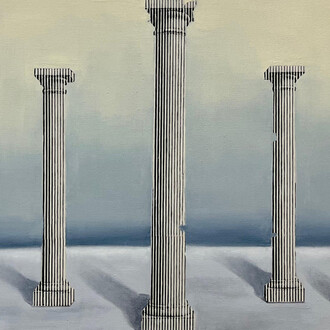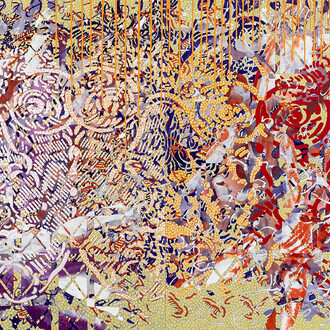From 8 October 2025, the Bourse de Commerce will host a major exhibition dedicated to Minimal art. Bringing together an exceptional group of works from the Pinault Collection in dialogue with those of prestigious collections, Minimal traces the diversity of this movement since the 1960s, when a whole generation of artists (Dan Flavin, Robert Ryman, On Kawara, Agnes Martin, François Morellet, among others) initiated a radical approach to art. The exhibition is curated by Jessica Morgan, director of Dia Art Foundation (New York), who has selected over a hundred works by some forty international artists.
The Minimal exhibition explores the global and international evolution of this movement, which since the early 1960s has radically reconsidered the status of artwork. Characterized by an economy of means, pared-down aesthetics, and a reconsider ation of the artwork’s placement in relation to the viewer, artists across Asia, Europe, North and South America challenged traditional methods of display. This approach invited a more direct, bodily interaction with the art, integrating the viewer and the environment into the artwork itself. While these transformations unfolded in distinct ways across different regions, they shared a common drive to expand the relationship between artwork and audience.
For instance, in Japan, the Mono-ha movement, focused on bringing ‘things’ together in their natural, unaltered states, highlighting the interdependence of objects, space, and viewer. In Brazil, neo-concrete artists embraced a more sensual abstrac tion, countering the rigid forms of concrete art and fostering an intimate viewer connection. Meanwhile, in Europe, movements like Zero in Germany and Arte Povera in Italy pushed the boundaries of sculpture through minimalist forms and direct engagement with space, while in the U.S., Minimalist artists rejected traditional compositional techniques in favor of simplicity and materiality. Despite being rooted in local contexts, these developments emerged simultaneously, challenging the American-dominated narrative of Minimalism.
Organised in seven themes—Light, Mono-ha, Balance, Surface, Grid, Monochrome, Materialism—the exhibition, curated by Jessica Morgan, Director Dia Art Foundation, will foreground these unique yet interconnected artistic developments world wide drawing on an exceptional group of works from the Pinault Collection, with additional loans from Dia Art Foundation and other private and public collections.
“Minimal. At this point in time, what exactly does this word conjure up? The Oxford Dictionary tells us that it can refer variously to: a quantitative definition (a neg ligible amount); a type of art featuring simple or geometric forms; unadorned clothing; music characterized by repetition; or a term relating to linguistics. Interestingly, in data available online, we can see the usage of ‘minimal’ over time with the word appearing more frequently in print from the mid-1960s until a crescendo in the late 1980s to early 1990s, before dropping off slightly since.
The high point of the curve invokes memories of Donna Karan and Calvin Klein, the minimal food movement, the architecture of John Pawson, minimal interior design, and the referencing of all of this in movies such as 9½ weeks (1986), which was famously filmed in part in Donald Judd’s legendary Spring Street loft building. Having now returned to a frequency of usage closer to that of the 1970s, one wonders what this mélange of his torical references – from the art-focused Minimalism of the 1960s to ‘90s minimal lifestyle branding—means to a new generation. Perhaps it is just one of a plethora of ‘styles’ to be adapted for use and applied as needed, but with no inherent dogma attached. Is ‘minimal’ like ‘curating’: an art term that has been so completely appropriated by the mainstream that any specificity it once had has now been lost?
This exhibition is not about Minimalism, which Google AI tells me is ‘a philosophy that involves living with fewer possessions and commitments’, not the art move ment I am referring to here. Minimal primarily brings together the remarkable and substantial body of work collected by François Pinault that is characterized by reductive forms, abstraction, geometric shapes, and an economy of means. Featuring one of the most remarkable collections of work by Agnes Martin and Robert Ryman, among others, at the centre of the Pinault Collection is a focus on some of the key practitioners of Minimal Art. While the selected works are not limited to a specific time frame, the artists represented here largely established their practices in a period spanning from the mid-1960s through the early 1980’s, a moment that witnessed a global revision of the status of the art object achieved through minimal aesthetics and the placement of the artwork in relation to the viewer. Artists in Asia, Europe, and North and South America subjected sculpture and wall based works to a radical reconsideration: no longer presented on pedestals or against walls at a discrete distance from the viewer, these works entered the space of the visitor, thereby incorporating the environment in which they were placed while calling for a direct corre spondence with the individual viewing subject. […]
Underlying the works included here is the desire to position the audience in the same field, thereby calling for a bodily correspondence between art and viewer through scale and proximity. In many parts of the world, this new understanding of three-dimensional form and its relationship to perception led to the development of a dialogue with performance—whether this was realised through the process-based making of the work, choreographic collaboration, or interaction with the artwork. Arguably this moment also witnessed the increasing use of new media such as photography, film, and video that further developed the relationship to ‘real time’, as suggested by the theatrical dialogue between subject and object. […]
How, then, to approach an exhibition that is not confined to an ism or art historical category, and which is primarily curated from a private collection—albeit one that totals over ten thousand works. While not looking to sublimate art into categories, I have grouped works according to classifications that are dictated by their formal, material, and processual concerns: light, grid, materialism, surface, monochrome, and balance. Artists reappear across categories to point to the fluidity rather than rigidity of these sections and the expansiveness of the artists’ work.
As the Pinault Collection has one of the most substantial collections of Mono-ha outside of Japan, the artists included, among them Lee Ufan, Kishio Suga, Koji Enokura, Susumu Koshimizu, Nobuo Sekine, and Jiro Takamatsu, feature significantly in the exhibition including the only space dedicated to a specific art historical category, demon strating the radical propositions of the artists involved. […]
While most artists are grouped in these thematic sections described here, some are presented outside of these categories. One artist included in Minimal is of such significance in the Pinault Collection that her work is exhibited in a solo room: Agnes Martin. On Kawara’s date paintings also hold an important place in the Pinault Collection and are featured in the unique vitrines that surround the Rotunda of the Bourse de Commerce as well as in a solo presentation in the Salon. Meg Webster has taken on the extraordinary space of the Rotunda at the Bourse de Commerce to create an interior landscape from natural materials. Finally, Charlotte Posenenske is presented not only in the thematic section concerned with Surface but also in a series of interventions around the Bourse de Commerce building using her Vierkantrohre serie D (Square tubes series D). […]"
(Text by Jessica Morgan, Curator of the exhibition and Director of Dia Art Foundation. Extract from the exhibition catalogue)















